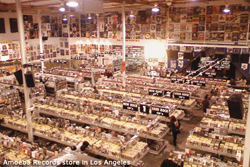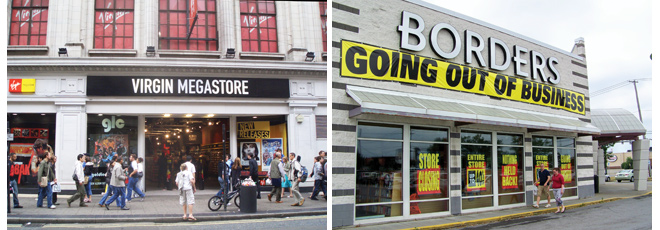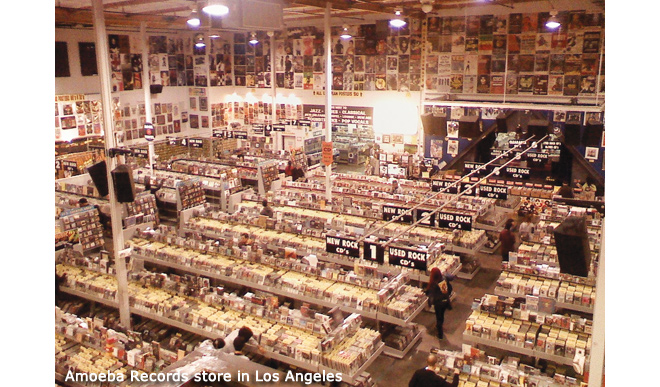Europe's online source of news, data & analysis for professionals involved in packaged media and new delivery technologies

FEATURE: Physical media are hanging on for dear life
Borders joins Tower Records and Virgin Megastore in the has-been entertainment retail chain category, while HMV attempts to reorganise. LARRY JAFFEE surveys the remaining bricks-and-mortar landscape on both sides of the Atlantic, and considers what further toll Internet delivery will take on packaged media.
How’s this for a metaphor? Last spring, when I first contemplated writing this article, I walked passed the old flagship Virgin Megastore building on London’s Oxford Street; it was being demolished and rebuilt for a skyscraper.
Around the corner down a bit on Charing Cross Road, what used to be Borders is now American fashion retail discounter TK Maxx. And back in the US, Borders this summer is liquidating the stores it hadn’t already closed. What is about those far-too-often final bank-ruptcy scenes at a home entertainment store that makes a consumer feel like a bit of a vulture, or a dinosaur?
On 27 July, as I picked through what heavily discounted spoils were left in the CD department of Borders at New York’s Columbus Circle, a mother tried to console her distraught four-year-old son, who couldn’t fathom the bold signs all around bellowing that the store was closing. “I am never going to read another book again,” the pre-schooler manages to squeak out between sobs. “Barnes & Noble is not the same,” she said.
B&N, the US’s No. 1 book brick-and-mortar book chain whose more than 700 ‘superstores’ feature sizable music and movie departments, could face the very same fate as Borders.
That’s if the 4 August prediction from Barclays analyst Alan Rifkin regarding a pending deal first announced in May by Liberty Media ultimately falls through: “In our view, this continued uncertainty supports our belief that significant challenges remain in completing a deal and that Barnes & Noble is unlikely to be successfully acquired”, Rifkin stated. If B&N goes the way of Borders, it’s what we call in America “the one-two punch,” or “the other shoe drops,” negatively impacting not only on book publishers, but also CD distributors and DVD producers.
Liberty Media, led by cable TV tycoon John Malone, initially was interested in acquiring a controlling stake the book retailer for its Nook e-reader, but ultimately opted for a $204 million minority investment.
Another curious acquisition was the $320 million Dish Network’s deal for Blockbuster, which has dominated the home video business the past several decades after driving nearly every mom-and-pop store and other competing chain out of business. What goes around comes around, indeed.


The Long Tail – only online?
It’s easy to blame e-commerce and Amazon.com’s deep discounting for the continuing slow death of physical media. But they’re quickly becoming the only place to buy the stuff.
This past spring I scoured the few last stores in Manhattan that still sold CDs for the new album from Robbie Robertson, How to Become Clairvoyant, to no avail. I then received an offer from Amazon to download the entire album digitally for $3.99, and of course, I took them up on it even though I was prepared to pay at retail $15 or so for a CD.
Four months after the album was released, Robertson makes available is a $300 limited-edition collectors’ set, 2500 of them signed by the musician himself. The set includes the CD, a bonus disc with 10 addi-tional tracks, three 180-gram vinyl LPs (containing the 22 tracks on the two CDs), and a DVD containing three multi-track files from the album.
Also included is a deluxe art book containing more than 50 pages of art, photos and notes from the album, eight tarot cards exclusively designed for this package, a set of five lithographs – each set individually numbered (three exclusive images by Richard Prince, one by Anton Corbijn and a 2011 Robbie Robertson Commemorative Canadian government stamp) and a ‘premium digital download’ of How to Become Clairvoyant. I’ll pass, but I guess an uber-fan with money to spare might buy this package online. Good luck finding it at retail.
Herein lies the paradox. The overhead of massive storefronts and deep CD and DVD catalogues, while fun to kill a few hours browsing, apparently is too steep these days for chains to offer the ‘long tail’ of choices.
Chris Anderson in his 2006 book The Long Tail: Why the Future of Business Is Selling Less of More, which I highly recommend, describes the retailing strategy of selling a large number of unique items in relatively small quantities – usually in addition to selling fewer popular items in large quantities. Amazon epitomises the Long Tail.
But it is possible for a packaged media retail environment to succeed, as evidenced by Amoeba Records, which since 1990 has called itself ‘The World’s Largest Independent Record Store’, encompassing three stores that also offer plenty of hard-to-find DVDs and even pre-recorded VHS videocassettes in Hollywood, San Francisco and Berkeley, California, each stocking more than 100,000 items. You owe it to yourself to see the Amoeba operation, which also sells plenty of used product that doesn’t apparently cannibalise sales of new releases.
“Amoeba Music began at a time when the huge chain stores were mercilessly swallowing up independent stores and local chain stores, depriving communities across the country of a personal relationship with their music outlets, and destroying the opportunity to discover a whole world of music beyond what corporate retailers wanted them to see”, the company explains on its website. “Amoeba arose out of that community of music lovers that wanted a better place for music than a corporate chain store – one with the widest possible selection, better service, and more respect for people’s ideas and lives.”
Live events, such as concerts, certainly help Amoeba pack in the punters. But the half dozen times or so I’ve been to the Hollywood store it’s always been packed, with a long queue waiting for an open till.

Will HMV’s plan work?
HMV, the first of the big-box entertainment retailers to pull out of New York in 2004, is currently determined to be last-man standing in the UK, with a reorganisation plan that includes closing under-performing stores, divesting its Waterstones book chain (the book publishing industry’s woes are another story in itself) and concentrating on elec-tronics. Virgin before it tried diversification, especially with mobile phones, but it didn’t work.
Meanwhile, over in the UK the major labels are planning to bail out HMV, which is good news considering Tower Records and Virgin Megastore pulled out everywhere in the past five years.
Earlier this year, HMV won a reprieve from creditors who offered terms that weren’t apparently available to Tower a few years ago or Borders this year. Financial analyst Nick Bubb, from Arden Partners, in a published report recently opined: “Against the odds, HMV has survived in the short term on the hopes of a successful switch to selling ‘technology’, but this seems to us to be a triumph of hope over experience and we would be surprised if the good results from the first six stores can be replicated in a wider roll-out...”
Speaking with analysts to discuss its most recent quarterly results, HMV chief executive Simon Fox reported that CDs currently account for about a quarter of HMV’s business, and that HMV’s share of the CD market is currently 30%-50%. Unfortunately, he did not address how important DVD was to the chain. But Fox predicted the entire CD market in the UK would be worth just £300 million in three years’ time, as manufacturers stop designing new CD players and carmakers opt for MP3 equipment.
If HMV merely maintains its share of the shrinking CD pie over the next three years, the company projects its annual revenues from CDs to fall to £120 million. That’s £145m of turnover that has to be replaced by “digital entertainment devices”.
Apple, beware Spotify
Well, speaking of digital entertainment devices, if I were Apple, even with its commanding iPod market share for MP3 players and its iTunes store, I’d be mightily worried about Spotify, which I realise has been in Europe for a while now and just earlier this summer reached the US. I was one of the lucky first testers invited to use the service because of my membership in BMI, the music publishing royalty collector.
Spotify simply delivers the promise of a ‘celestial jukebox’ at your fingertips. It’s Napster circa 1999 or Limewire a few years later – but legal. Pretty much whatever you want, there it is – in a second. Whereas iTunes satisfies immediate gratification at 99 cents a track, Spotify lets you hear not only that one song you yearned to listen to again, there’s the entire CD! Even if you own the CD, you don’t have to go looking for it.
Okay, Spotify comes with some limitations, such as the intermittent advertisements encouraging its premium service option or promoting some new album release. But that’s a fairly small price to pay. Incidentally, more than 1 million subscribers in Europe already pay the monthly premium subscription fee, while more than 10 million users go the free route.
Billboard reported that Spotify in just three weeks amassed at least 1 million total US users, and 70,000 paid subscribers in the first week. That was just from those lucky enough to be invited to try the service, and it’s still not open to the masses. But that’s all going to change, especially Spotify’s partnership with Facebook deepens and they become more intertwined.
Spotify’s success is not at all surprising. Consumers, especially of the younger generation, have flocked to Pandora and YouTube to access (i.e., not pay) for music. Obviously time will tell whether Spotify will be able to sell enough advertising and subscriptions to make up for the licensing guaran-tees it made to the major labels in exchange for the music.
But any labels or musicians who want to make money from CDs better wow buyers with unforgettable packaging. No-frills jewel cases just aren’t going to cut it any more. And obviously some corporate entity is going to try to come up with a movie version of Spotify that eventually will have severe ramifications for the future of DVDs and Blu-ray discs. It already happened with television and Hulu.com in the US. A startup called Zediva started streaming popular Hollywood movies for $1 rentals, and unlike Spotify, did not gain licenses from copyright owners. A US federal judge in early August handed down a preliminary injunction, at the request of studios, that what Zediva was doing constituted copyright infringement.
Let’s go back to Spotify’s limitations. Well obviously there’s some tradeoff in sound quality with MP3s, which don’t match CDs. But consumers have demonstrated that they’re willing to sacrifice sound quality for convenience and portability. Are there enough audiophiles – and videophiles for that matter – to sustain an entertainment ecosystem to cater to their needs?
Another Spotify limitation is that the music is streamed, so it’s not really owned. Maybe that’s better for a hard drive already nearly maxed out. And Spotify has a playlist-sharing feature that is an answer of sorts to the soon-to-be-lost art of burned CDs – the successor to mix tapes – which started many a romance.

‘The Cloud’ cometh
Not having actual possession of a digital file is the premise of ‘cloud’-based computing, a direction that Steve Jobs and Apple are certainly headed. The new MacBook Pro laptops will not have an optical drive. What does this trend mean for blank media?
Even Bill Gates in November 2005 had the foresight to see where things were headed. The Microsoft chairman said of HD DVD (before it lost to Blu-ray) – then more a concept than reality: “Understand that this is the last physical format there will ever be. Everything’s going to be streamed directly or on a hard disk.”
Oddly enough, UK independent filmmakers were told at a London seminar by the organisation Film Means Business I attended in April that they should not even bother with cinema distribution because it’s nearly impossible to compete with Hollywood output – digital is where it’s at. The experts viewed DVD as dying off.
I moved house over a year ago, and started selling off large portions of my immense music CD and movie DVD collections. It’s interesting how what once seemed like must-have purchases were so easily dispensed of. On the movie side, it just didn’t seem to make sense to keep boxed sets of TV shows (e.g., Hill Street Blues, a season of Cheers, etc.) that maybe I watched once and really had no plans to go back to. Of course, there were certain keepers like maybe 100 favourite movies and a few hundred CDs and vinyl records that had either some sort of sentimental value or an artifact quality that can’t be replicated in the digital realm.
What I’d like to see is some sort of old media-meets-new media hybrid that really brings something to the table, or more accurately tablet. For example, my favourite book of 2009 was goth-rocker Nick Cave’s novel, The Death of Bunny Munro, whose enhanced edition was tailor-made for all Apple iOS devices. An app was optimised for the iPhone and iPad. It includes the full ebook, the unabridged audiobook synchronised to the text, read by the author with an original soundtrack by Nick Cave and Warren Ellis, and 11 videos of Cave reading from the novel. That’s what I call multimedia, or now ‘transmedia’ – trying to keep up the new lingo.
According to Wikipedia, ‘transmedia storytelling’ is a technique of telling stories across multiple platforms and formats, recognised for its use by mass media to develop media franchises. It was the type of thing that CD-ROM started doing in the 1990s, and DVD-ROM never really delivered en masse, unfortunately, as more rich content was posted on the Internet. It probably would be the type of intel-ligent product that looters would decide not to steal.
In a letter to The New York Times about the recent senseless violence in London and other cities, Arnold Goodman of Denver, Colorado, observed: “During the rioting that gripped England, a bit of telling irony was seen at a shopping mall, in which widespread looting had struck. Rampaging mobs had broken into virtually every shop there, stealing everything from designer clothing to electronics. One store stood alone, however, its windows intact and its goods untouched. It was a bookstore, wherein perhaps the best hope for a better future lay ignored.”
And Sony DADC’s distribution centre in Enfield, North London, which reportedly held as much as 30 million discs of CDs, DVDs, Blu-ray and videogame discs and blank media, was burned to the ground. As if physical media needed any more help.

Based in New York, LARRY JAFFEE edited Medialine from 1998 to 2005, and oversaw its annual DVD conference. He’s been a regular contributor to One to One, Digital2Disc and edited two issues of MediaPack. Jaffee is currently a consultant to the Media-Tech Association. He is the author of two books, Albert Square & Me: The Actors of EastEnders and Walford State of Mind. Contact: www.wgazette.com/
This is one of many editorial features included in the annual DVD and Beyond 2011 magazine. Ask for your free copy.
Story filed 29.09.11




















